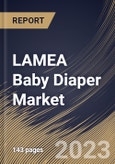The market is a multifaceted, ever-evolving sector that plays a pivotal role in the lives of parents, caregivers, and, most importantly, babies. It encompasses many products designed to provide comfort, convenience, and hygiene for infants and toddlers. Baby diapers, an integral part of early childhood care, have been adopted in the region, spanning diverse cultures, economic backgrounds, and demographics. The adoption of these is not only driven by convenience but also by the growing awareness of the importance of hygiene and comfort for infants.
The trend of urbanization has led to smaller living spaces, increased working hours, and a faster-paced lifestyle. As a result, parents often opt for disposable diapers due to their convenience and time-saving benefits. Evolving parenting roles, with both parents often working, have increased the demand for diapers as they offer a practical solution for busy families. Diaper use has increased due to increased awareness of the significance of maintaining a good standard of hygiene for infants.
Some countries in the LAMEA region have been working to improve maternal and child healthcare services. Initiatives focusing on prenatal care, safe deliveries, and postnatal care contribute to an increased emphasis on the well-being of newborns. For example, governments may invest in programs that offer free or subsidized healthcare services for pregnant women and infants. Various non-governmental organizations (NGOs) often promote maternal and child health in the LAMEA region. Therefore, the rising number of newborns in several countries of the LAMEA region will boost the demand for these in the region.
The Brazil market dominated the LAMEA Baby Diaper Market, By Country in 2022, and would continue to be a dominant market till 2030; thereby, achieving a market value of $2,547.4 Million by 2030. The Argentina market is showcasing a CAGR of 8% during (2023 - 2030). Additionally, The UAE market would register a CAGR of 7.1% during (2023 - 2030).
Based on Type, the market is segmented into Conventional, and Organic. Based on Product, the market is segmented into Disposable, and Non-Disposable. Based on Distribution Channel, the market is segmented into Offline, and Online. Based on countries, the market is segmented into Brazil, Argentina, UAE, Saudi Arabia, South Africa, Nigeria, and Rest of LAMEA.
The market research report covers the analysis of key stake holders of the market. Key companies profiled in the report include The Procter and Gamble Company, Kimberly-Clark Corporation, Hengan International Group Company Limited, Unicharm Corporation (DSG International (Thailand) PLC), Johnson & Johnson, Ontex BV, The Hain Celestial Group, Inc., The Honest Company, Inc., Essity AB, and Kao Corporation
Scope of the Study
Market Segments Covered in the Report:
By Type (Volume, Million Units, USD Billion, 2019 to 2030)- Conventional
- Organic
- Disposable
- Non-Disposable
- Offline
- Online
- Brazil
- Argentina
- UAE
- Saudi Arabia
- South Africa
- Nigeria
- Rest of LAMEA
Key Market Players
List of Companies Profiled in the Report:
- The Procter and Gamble Company
- Kimberly-Clark Corporation
- Hengan International Group Company Limited
- Unicharm Corporation (DSG International (Thailand) PLC)
- Johnson & Johnson
- Ontex BV
- The Hain Celestial Group, Inc.
- The Honest Company, Inc.
- Essity AB
- Kao Corporation
Unique Offerings
- Exhaustive coverage
- The highest number of Market tables and figures
- Subscription-based model available
- Guaranteed best price
- Assured post sales research support with 10% customization free
Table of Contents
Companies Mentioned
- The Procter and Gamble Company
- Kimberly-Clark Corporation
- Hengan International Group Company Limited
- Unicharm Corporation (DSG International (Thailand) PLC)
- Johnson & Johnson
- Ontex BV
- The Hain Celestial Group, Inc.
- The Honest Company, Inc.
- Essity AB
- Kao Corporation
Methodology

LOADING...








